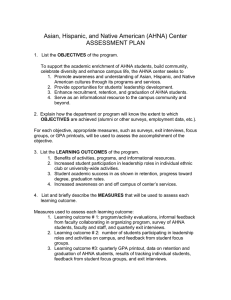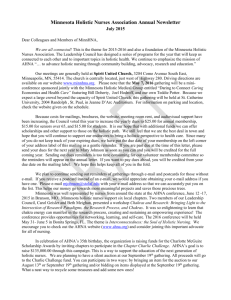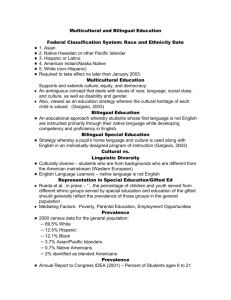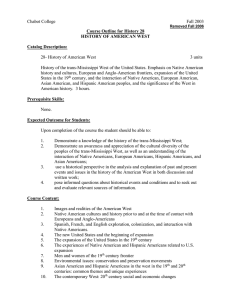Assessment Report —June 30, 2008 July 1, 2007 PROGRAM(S) ASSESSED
advertisement
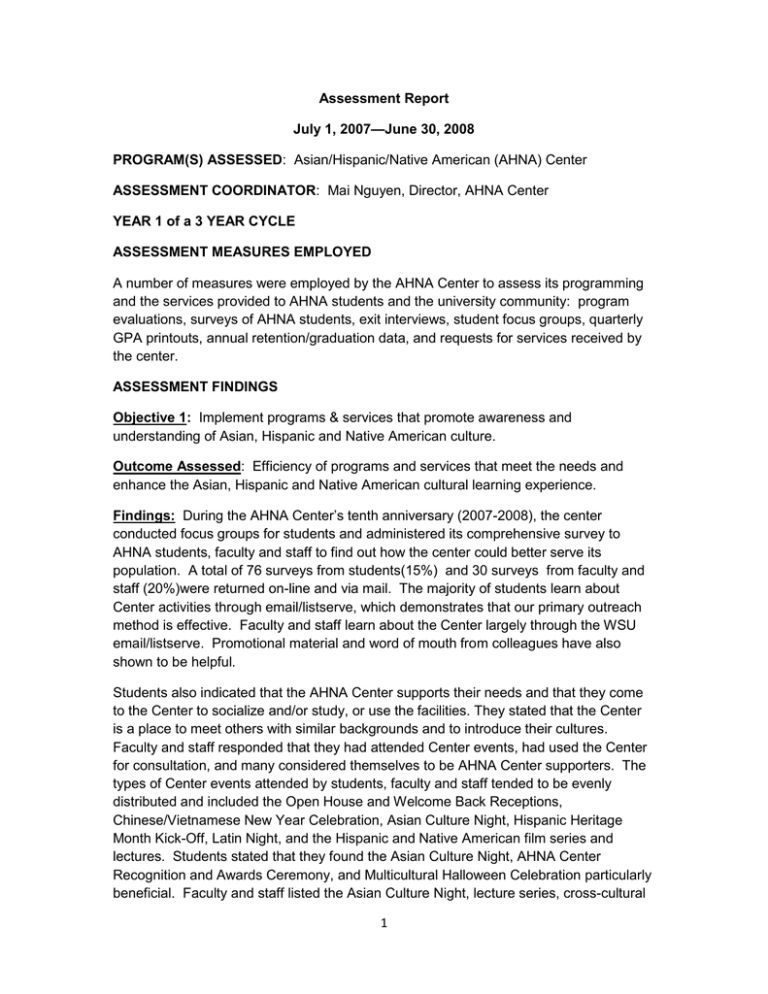
Assessment Report July 1, 2007—June 30, 2008 PROGRAM(S) ASSESSED: Asian/Hispanic/Native American (AHNA) Center ASSESSMENT COORDINATOR: Mai Nguyen, Director, AHNA Center YEAR 1 of a 3 YEAR CYCLE ASSESSMENT MEASURES EMPLOYED A number of measures were employed by the AHNA Center to assess its programming and the services provided to AHNA students and the university community: program evaluations, surveys of AHNA students, exit interviews, student focus groups, quarterly GPA printouts, annual retention/graduation data, and requests for services received by the center. ASSESSMENT FINDINGS Objective 1: Implement programs & services that promote awareness and understanding of Asian, Hispanic and Native American culture. Outcome Assessed: Efficiency of programs and services that meet the needs and enhance the Asian, Hispanic and Native American cultural learning experience. Findings: During the AHNA Center’s tenth anniversary (2007-2008), the center conducted focus groups for students and administered its comprehensive survey to AHNA students, faculty and staff to find out how the center could better serve its population. A total of 76 surveys from students(15%) and 30 surveys from faculty and staff (20%)were returned on-line and via mail. The majority of students learn about Center activities through email/listserve, which demonstrates that our primary outreach method is effective. Faculty and staff learn about the Center largely through the WSU email/listserve. Promotional material and word of mouth from colleagues have also shown to be helpful. Students also indicated that the AHNA Center supports their needs and that they come to the Center to socialize and/or study, or use the facilities. They stated that the Center is a place to meet others with similar backgrounds and to introduce their cultures. Faculty and staff responded that they had attended Center events, had used the Center for consultation, and many considered themselves to be AHNA Center supporters. The types of Center events attended by students, faculty and staff tended to be evenly distributed and included the Open House and Welcome Back Receptions, Chinese/Vietnamese New Year Celebration, Asian Culture Night, Hispanic Heritage Month Kick-Off, Latin Night, and the Hispanic and Native American film series and lectures. Students stated that they found the Asian Culture Night, AHNA Center Recognition and Awards Ceremony, and Multicultural Halloween Celebration particularly beneficial. Faculty and staff listed the Asian Culture Night, lecture series, cross-cultural 1 exhibitions as most beneficial, with one person offering: “I believe that all these activities are beneficial to our campus community. I would like to see them continued.” When asked what other programs or activities students, faculty and staff would like to see, a variety of responses were offered, including: piñata party, language classes, more conferences for Latino students, inviting more prominent speakers, and hosting a scholarship program. Regarding AHNA Center cultural contributions, students, faculty and staff agreed that the AHNA Center has contributed to the better understanding of the Asian, Hispanic, and Native American cultures on campus. Many of the comments either suggested programming we already provide, or were extremely supportive and encouraging of our existing programming, events, and mission. A few sample of the remaining comments were all positive expressions of appreciation for AHNA Center, such as “I took my friends as guests to the Halloween Night and we loved it;” “AHNA Center has literally been my campus home every since I attended WSU as a PSEO in 2003. It has a warm atmosphere filled with great and enlightening people;” “Thank you for your hard work. Events and services that your are providing to students are very beneficial and educational.” In summary, through this comprehensive survey of students, faculty and staff, the focus groups, and our general observation of our events and programs, we are pleased that the Center is succeeding its goal of increasing cultural awareness on campus. We are also succeeding in broadening our audience to the general public in Dayton and surrounding areas, as witnessed by the consistent report of our events from local media and community’s participation in our Asian Culture Night, Multicultural Halloween Celebration, and Chinese/Vietnamese New Year Celebration. Objective 2: Provide opportunities for students’ leadership development. Outcome Assessed: number of students actively participating in activities and taking on broader leadership roles on and off-campus. Finding: In the survey, students stated that the Center helps them become stronger and has increased their leadership and communication skills. Annually, the AHNA Student Council plays a major role in organizing the popular Multicultural Halloween Celebration which attracted 1,500 people last year. For its active participation and leadership role on campus activities, the AHNA Student Council, under the leadership of Ralph Casareno, was awarded the “Innovative Award for an Outstanding Student Organization” from the Office of Student Activities. Additionally, Nancy Scott, President, Association of Native American Students, also received the “Outstanding Senior Leadership Award” from the Office of Student Activities. The AHNA Center was once again successful in securing financial support from the Student Organization Budget Committee to send three (Asian, Hispanic, and Native American) students to attend the 2008 National Conference on Race and Ethnicity (NCORE) conference in Orlando, Florida, in June. Additionally, AHNA students also attend leadership conferences held annually in the Midwest such as the Midwest Asian American Student Union (MAASU) and the Hispanic Leadership Institute in Chicago. Fiscal year 2007-2008 was the most 2 successful year for AHNA students in their scholarship fundraising efforts. The Asian Student Association raised $1,850; Latinos Involved In Further Education raised $760; and Association of Native American Students raised $527. This money is awarded to pertinent students who show potential leadership skills and who are in good academic standing. Objective 3: Enhance recruitment, retention and graduation of AHNA students. Outcome Assessed: Effectiveness of providing academic, social and cultural support to AHNA students. Finding: The AHNA Center continuously monitors the academic progress of students via quarterly GPA printouts. The Center has an early intervention strategy to inform students and parents about the different academic support services when students’ GPAs are slightly above 2.0 or below 2.0. The first-year retention rate for AHNA students is 75.9% for Fall 2007. The overall university’s first-year retention rate for Fall 2007 is 69.7%. The six-year graduation rate for AHNA students for cohort 2000 is 40.4%, compared to the overall university six-year graduation rate of 43.5% for that cohort. The enrollment data reveals an increase of Asian, Hispanic and Native students at WSU at the undergraduate level. The AHNA Center recognizes the attendance of a number of siblings of Asian and Hispanic students who belong to the Asian Student Association and Latinos Involved in Further Education. Year 2006 Asian: 505 students (Undergraduate: 283; Graduate: 222) Year 2007 Asian: 525 students (Undergraduate: 317; Graduate: 208) Hispanic: 243 students (Undergraduate: 186; Graduate: 57) Hispanic: 240 students (Undergraduate: 191; Graduate: 49) Native: 54 students (Undergraduate: 47; Graduate: 7) Native: 60 students (Undergraduate: 53; Graduate: 7) Objective 4: Serve as an informational resource to the campus community and beyond. Outcome Assessed: Impact of AHNA Center on campus and in the Dayton community. Finding: The center continues to respond to requests from offices on campus and from the community to conduct diversity activities, to assist with translation, and to speak to students at local school districts. The center also works collaboratively with neighboring colleges and universities and with others throughout the state of Ohio. Mai Nguyen, director of the AHNA Center, was elected as founding President of the Ohio Consortium of Multicultural Centers in Higher Education in May 2008. The consortium’s mission is to 3 enhance the work of multicultural centers on Ohio campuses, to share resources, and to provide a supportive professional network. PROGRAM IMPROVEMENT The Center initiated the first Latinos Unidos Parents Association (L.U.P.A) at WSU to increase the retention and graduation rate of Latino students and to assist the university’s effort in recruiting more Latino students to WSU. The Center changed the Fall Open House from the afternoon to an evening event where AHNA parents and students are invited to attend. ASSESSMENT COMPLIANCE Explain deviations from the plan (if any) N/A NEW ASSESSMENT DEVELOPMENTS N/A 4
